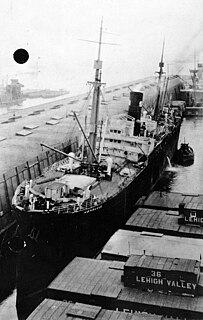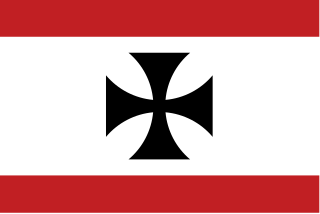This page is based on this
Wikipedia article Text is available under the
CC BY-SA 4.0 license; additional terms may apply.
Images, videos and audio are available under their respective licenses.

The Grand Trunk Milwaukee Car Ferry Company was the Grand Trunk Western Railroad's subsidiary company operating its Lake Michigan railroad car ferry operations between Muskegon, Michigan, and Milwaukee, Wisconsin, from 1905 to 1978. Major railroad companies in Michigan used rail ferry vessels to transport rail cars across Lake Michigan from Michigan's western shore to eastern Wisconsin to avoid rail traffic congestion in Chicago.

Trondhjems mekaniske Værksted or TMV was a major shipbuilding company in Trondheim, Norway.

Neptun Werft is a German shipbuilding company, headquartered in Rostock. Since 1997 it has been part of the Meyer Neptun Group together with Meyer Werft in Papenburg.

The Polson Iron Works was an Ontario based firm which built large steam engines, and ships, barges and dredges.
Sir William Arrol & Co. was a leading Scottish civil engineering and construction business founded by William Arrol and based in Glasgow. It built some of the most famous bridges in the United Kingdom including the Forth Bridge and Tower Bridge in London.

The first USS Honolulu (ID-1843) was a cargo ship that served in the United States Navy probably from 1918 to 1919.
Mironave was a 1,125 GRT cargo ship that was built as a passenger ship in 1938 by Schiffbau-Gesellschaft Unterweser AG, Wesermünde, Germany for German owners. In 1940, she was requisitioned by the Kriegsmarine. Seized by the Allies in 1945, she was passed to the Ministry of War Transport (MoWT) and renamed Empire Concave. In 1946, she was passed to the Norwegian Government and renamed Galtnes. She was sold into merchant service in 1947 and renamed Ila. In 1952, she was sold to Brazil and was renamed São Leopoldo. In 1965, a further sale saw her renamed Mironave. She was still in active service in 1982, when a further sale took place.
Klio was the name of two ships operated by Dampschiffahrts Gesellschaft Neptun AG.
Klio was a 1,403 GRT cargo ship that was built in 1924 by AG Weser, Bremen, Germany for Neptun Line. In 1945, she was seized by the Allies and passed to the Ministry of War Transport (MoWT), renamed Empire Conclyde. In 1946, she was passed to the Soviet Union and renamed Shota Rustavelli.
A number of steamships have carried the name Paris, after the French capital city.
Bessel was a cargo ship that was built in 1925 as Sorrento by AG Weser, Bremen for German owners. She was sold in 1926 and renamed Bessel. She was seized by the Allies in Vigo, Spain, in May 1945, passed to the Ministry of War Transport (MoWT) and renamed Empire Coniston. In 1946, she was lent to the Danish Government and was allocated to them in 1947. She was sold into Danish merchant service and renamed Birgitte Skou. In 1959, she was sold to Italy and renamed N Martini. She was renamed Nicolo Martini in 1961, serving until 1972 when she ran aground at Portoscuso, Sardinia. Although refloated she was declared a total loss and was scrapped in 1973.
Akademik Karpinsky was a 1,122 GRT cargo ship that was built in 1936 as Thalia by Nordseewerke, Emden, Germany for German owners. She was interned at Cadiz, Spain in 1943, and surrendered to the Allies in May 1945. Thalia passed to the Ministry of War Transport (MoWT) and was renamed Empire Consett. In 1946, she was transferred to the Soviet Union and renamed Akademik Karpinsky, serving until 31 August 1953 when she foundered.
Thalia was the name of two motor vessels operated by Dampfschiffahrts-Gesellschaft Neptun.

Leander was a 989 GRT coaster that was built in 1925 by Atlas Werke AG, Hamburg, Germany. She was captured by the British Royal Navy in 1939 and impressed into service as Empire Crusader, serving until bombed and sunk in 1940.
Krasnodar (Краснода́р) was a 4,186 GRT cargo ship that was built in 1925 as Skåneland by Kockums Mekaniska Verkstad, Malmö, Sweden for Swedish owners. In 1928, she was sold to Germany and renamed Pernambuco. She was seized as a war prize in 1945, passing to the Ministry of War Transport (MoWT) and being renamed Empire Dart. In 1946, she was transferred to the Soviet Union and was renamed Krasnodar, serving until she was scrapped in 1975.
Kirovograd was a 2,883 GRT cargo ship that was built in 1929 as Hercules by AG Weser, Bremen, Germany for Dampfschiffahrts-Gesellschaft Neptun. She was seized by the British in May 1945, passed to the Ministry of War Transport (MoWT) and renamed Empire Dovey. In 1946, she was transferred to the Soviet Union under the terms of the Potsdam Agreement and renamed Kirovograd. She served until 1968, when she was scrapped.
Two ships of the Deutsche Dampfschiffahrts-Gesellschaft Hansa were named Kattenturm.
Several steamships have borne the name Sirius:

DDG Hansa, short for Deutsche Dampfschiffahrts-Gesellschaft Hansa was a major German shipping company specialising in heavy freight and scheduled traffic between Europe and the Far East. Founded in Bremen in 1881, the company declared bankruptcy in 1980.
Holm & Molzen was a German company principally known for ship management between 1890 and 1932.






